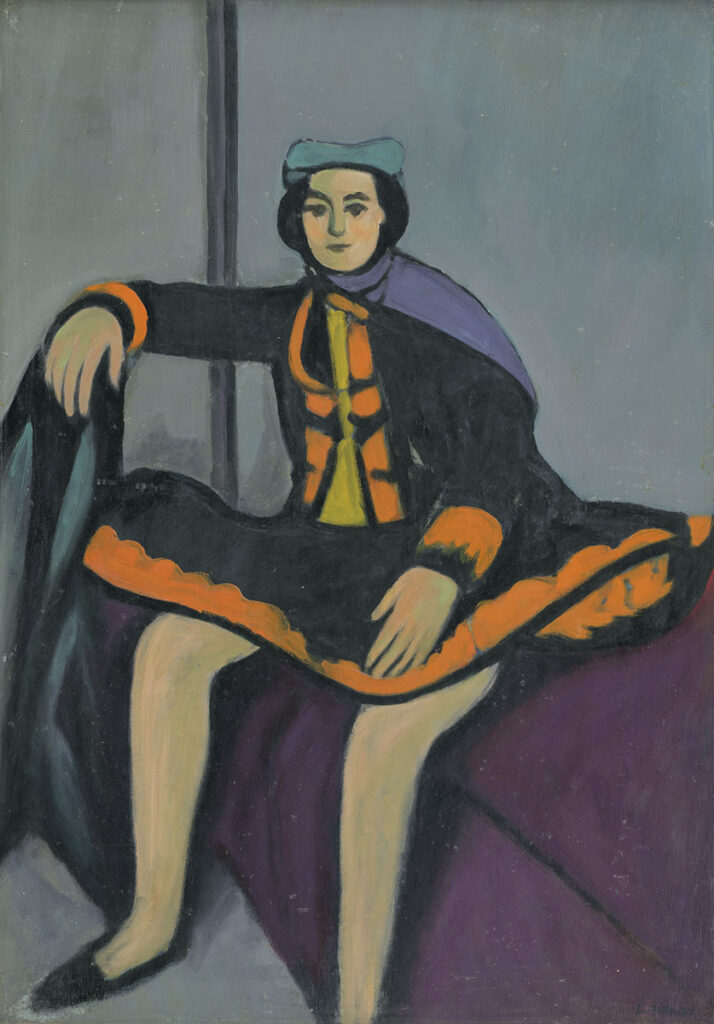Eugen Nevan is usually recognised as a part of Slovak interwar fine art modernism, also known as Generation 1909, specifically its so-called “Prague branch”. Other members of Generation 1909 include Cyprián Majerník, Ján Želibský, Bedrich Hoffstädter, Štefan Bednár, Peter Matejka, Rudolf Pribiš and other upcoming artists of the 1930s. The term itself was coined by Karol Vaculík and other curators of the Slovak National Gallery at the 1964 exhibition titled Generation 1909 – Conscience of Time. However, classifying Evan as a member of the not-so-homogenous group is not always universally accepted as he was the youngest of them and his artistic inclinations were related more to the upcoming artists of the World War II generation. [1]
Eugen Nevan’s work is inspired by French Fauvism, his early period especially by André Derain. In 1937, during his studies at the Academy of Fine Arts in Prague, he had a chance to visit Paris and got influenced by the works of Henri Matisse, specifically by his simplified and elegant female contours set in decorative interiors. Nevan was a typical figural artist – female postures dominated his balanced compositions characterised by flat painting style, vivid colours and expressive black contours. His most favourite motive was the theatrical environment, especially the backstage – resting or changing ballerinas, dancers and actresses in the intimacy of their dressing rooms. After all, dance was a part of Nevan’slife – his wife was a professional dancer, he himself became interested in expressive dance, joined a ballet association and later became a professional dance judge. [2]
During World War II, he spent some time working on anti-war themes which got him a little closer to his older colleagues from Generation 1909. The change was also apparent in the reduced colour palette of his paintings. During this time, he tried to balance all the war imagery with calmer landscape paintings, often featuring resting persons. After the war, he returned to his themes from the pre-war period, but he focused on more geometrically abstract shapes, reduced the background to a minimalist single-colour surface and the compositions were dominated by a single central figure. At the end of the 1940s, a new motive emerges in his work – a country girl in a folk costume. Due to his mental illness, Eugen Nevan did not continue in the development of his professional skills during the 1950s and 1960s. At this time, he focused mostly on his previous motives he would paint on a rather routine basis. [3]
Nitra Gallery’s collection includes a piece titled Sitting “In Spanish Costume” from 1960 which is a part of Eugen Nevan’s later period. The painting depicts a woman sitting on a sofa, posing in a costume. All the shapes, composition and the figure’s anatomy are very simplified. There is an almost non-existent monochromatic background and the whole colour palette is very reduced, with the exception of the costume details. In comparison with other portraits of sitting women from Nevan’s peak period, (e.g. Sitting Woman from 1938 or Sitting Woman from 1946), there is an apparent “tiredness” of the indistinctive, stiff composition and the overall expression. However, what is interesting about this image is its comparison with Nevan’s costume designs from the turn of the 1950s and 1960s, such as Women Costume Design V or Toreador Costume Design II. The painting in our collection features a strange synthesis of these costume designs. Could this artistically simple and unclear, or perhaps even bipolar (and authentic, in its way) depiction of the central motive – the costume – bear signs of Nevan’s mental illness?
Omar Mirza
June 2020
Eugen Nevan (birth name Neufeld) was born on January 18, 1914 in Mohács, Hungary. He studied in Prague; at first he attended the Faculty of Medicine from 1934 to 1936 and from 1935, he also took on painting under professor Robert Lisovskyi at the Academy of Ukraine. Later, from 1936 to 1939, he studied painting at the Academy of Fine Arts in Prague under professor Willy Nowak. During World War II, he was three times almost deported to a concentration camp due to his Jewish origins. [4] He was forced to lead a semi-illegal life and in 1943, he managed to obtain all the necessary documents he needed to legally change his name to Evan, which he used only as a pseudonym until then. In 1943, he became a member of the Mánes Association of Fine Artists which organised his first solo exhibition in 1944. In the same year, he became a member of the 29th August Artists Group. In 1946, he was made a member of the Hollar Association of Czech Graphic Artists. In 1946 and 1947, he went on study trips to France and Switzerland. From 1948 to 1950, he worked as an assistant for prof. Vladimír Sychra at the Academy of Fine Arts in Prague. In 1950, he moved to Bratislava where he worked as a special assistant at the Faculty of Education at Comenius University until 1953. After that, he worked as a freelance artist. In 1963, he participated at an exhibition held by the Life group and also became its member. In the late 1940s, he was diagnosed with a mental illness, but despite its continuous treatment, he was not able to further evolve his artistic career after 1956. [5] He ended his life voluntarily on October 15, 1967 in Bratislava.
Sources
[2] VÁROSS, Marian: Eugen Nevan. Bratislava : Slovenské vydavateľstvo krásnej literatúry, 1964, p. 24.
[3] Available at: https://artcapital.sk/autori/nevan-eugen (Accessed on June 24, 2020).
[4] ABELOVSKÝ, Ján – BAJCUROVÁ, Katarína: Výtvarná moderna Slovenska. Maliarstvo a sochárstvo 1890 – 1949. [Slovak Fine Art Modernism. Painting and Sculpture 1890 – 1949] Bratislava : Peter Popelka; Slovart, 1997, p. 540. ISBN 80-967203-3-3.
[5] TROJANOVÁ, p. 23; VÁROSS, p. 33.
No.: O 208
Artist: Eugen Nevan
Title: Sitting „In Spanish Costume”
Year of origin: 1960
Technique: oil
Material: plywood
Dimensions: 78 x 55 cm
Signature: bottom right, in brush: E. Nevan
